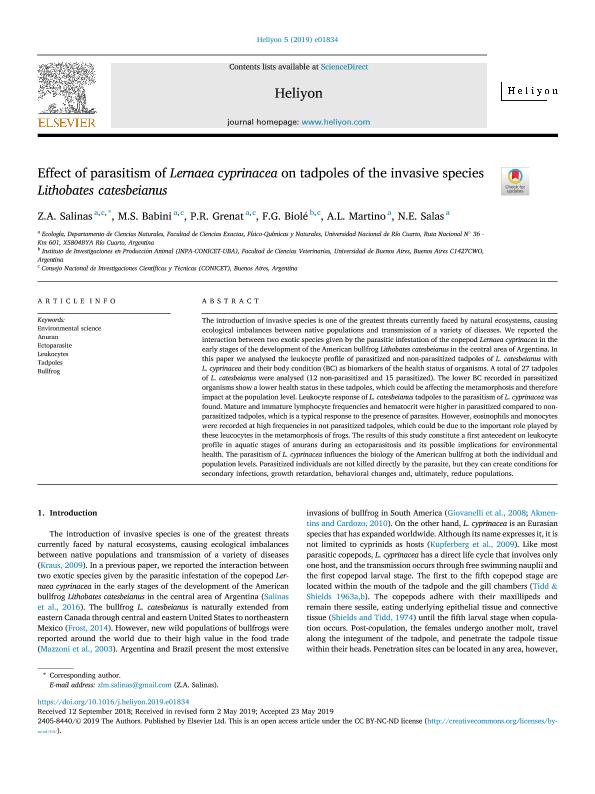Artículo
Effect of parasitism of Lernaea cyprinacea on tadpoles of the invasive species Lithobates catesbeianus
Salinas, Zulma Anahí ; Babini, María Selene
; Babini, María Selene ; Grenat, Pablo Raúl
; Grenat, Pablo Raúl ; Biolé, Fernanda Gabriela
; Biolé, Fernanda Gabriela ; Martino, Adolfo Ludovico; Salas, Nancy Edith
; Martino, Adolfo Ludovico; Salas, Nancy Edith
 ; Babini, María Selene
; Babini, María Selene ; Grenat, Pablo Raúl
; Grenat, Pablo Raúl ; Biolé, Fernanda Gabriela
; Biolé, Fernanda Gabriela ; Martino, Adolfo Ludovico; Salas, Nancy Edith
; Martino, Adolfo Ludovico; Salas, Nancy Edith
Fecha de publicación:
06/2019
Editorial:
Elsevier
Revista:
Heliyon
ISSN:
2405-8440
Idioma:
Inglés
Tipo de recurso:
Artículo publicado
Clasificación temática:
Resumen
The introduction of invasive species is one of the greatest threats currently faced by natural ecosystems, causing ecological imbalances between native populations and transmission of a variety of diseases. We reported the interaction between two exotic species given by the parasitic infestation of the copepod Lernaea cyprinacea in the early stages of the development of the American bullfrog Lithobates catesbeianus in the central area of Argentina. In this paper we analysed the leukocyte profile of parasitized and non-parasitized tadpoles of L. catesbeianus with L. cyprinacea and their body condition (BC) as biomarkers of the health status of organisms. A total of 27 tadpoles of L. catesbeianus were analysed (12 non-parasitized and 15 parasitized). The lower BC recorded in parasitized organisms show a lower health status in these tadpoles, which could be affecting the metamorphosis and therefore impact at the population level. Leukocyte response of L. catesbeianus tadpoles to the parasitism of L. cyprinacea was found. Mature and immature lymphocyte frequencies and hematocrit were higher in parasitized compared to non-parasitized tadpoles, which is a typical response to the presence of parasites. However, eosinophils and monocytes were recorded at high frequencies in not parasitized tadpoles, which could be due to the important role played by these leucocytes in the metamorphosis of frogs. The results of this study constitute a first antecedent on leukocyte profile in aquatic stages of anurans during an ectoparasitosis and its possible implications for environmental health. The parasitism of L. cyprinacea influences the biology of the American bullfrog at both the individual and population levels. Parasitized individuals are not killed directly by the parasite, but they can create conditions for secondary infections, growth retardation, behavioral changes and, ultimately, reduce populations.
Palabras clave:
ANURAN
,
BULLFROG
,
ECTOPARASITE
,
ENVIRONMENTAL SCIENCE
,
LEUKOCYTES
,
TADPOLES
Archivos asociados
Licencia
Identificadores
Colecciones
Articulos (ICBIA)
Articulos de INSTITUTO DE CIENCIAS DE LA TIERRA, BIODIVERSIDAD Y AMBIENTE
Articulos de INSTITUTO DE CIENCIAS DE LA TIERRA, BIODIVERSIDAD Y AMBIENTE
Articulos(CCT - CORDOBA)
Articulos de CTRO.CIENTIFICO TECNOL.CONICET - CORDOBA
Articulos de CTRO.CIENTIFICO TECNOL.CONICET - CORDOBA
Articulos(INPA)
Articulos de UNIDAD EJECUTORA DE INVESTIGACIONES EN PRODUCCION ANIMAL
Articulos de UNIDAD EJECUTORA DE INVESTIGACIONES EN PRODUCCION ANIMAL
Citación
Salinas, Zulma Anahí; Babini, María Selene; Grenat, Pablo Raúl; Biolé, Fernanda Gabriela; Martino, Adolfo Ludovico; et al.; Effect of parasitism of Lernaea cyprinacea on tadpoles of the invasive species Lithobates catesbeianus; Elsevier; Heliyon; 5; 6; 6-2019; 1-6; E01834
Compartir
Altmétricas



